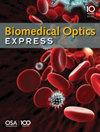通过血管内 OCT 和人工智能评估冠状动脉钙化和心血管预后
IF 3.2
2区 医学
Q2 BIOCHEMICAL RESEARCH METHODS
引用次数: 0
摘要
冠状动脉钙化(CAC)是动脉粥样硬化的标志物,被认为与较差的临床预后有关。然而,目前还缺乏来自大规模高分辨率成像数据的证据。我们提出了一种新颖的深度学习方法,它能在使用高效生成的稀疏标签训练的海量血管内 OCT 数据中自动识别和量化 CAC。我们收集了来自 1,048 名患者的 1,106,291 张 OCT 图像,并利用这些图像对该方法进行了训练和评估。CAC 分割的 Dice 相似系数和 CAC 分类的准确率分别为 0.693 和 0.932,接近人类水平。将该方法应用于 1259 例 ST 段抬高的心肌梗死患者的 OCT 图像,我们发现,罪魁祸首血管钙化范围更大、更严重的患者发生重大不良心脑血管事件(MACCE)的可能性明显更高(p <0.05),而非罪魁祸首血管的 CAC 在 MACCE 组和非 MACCE 组之间没有显著差异。本文章由计算机程序翻译,如有差异,请以英文原文为准。
Coronary artery calcification and cardiovascular outcome as assessed by intravascular OCT and artificial intelligence
Coronary artery calcification (CAC) is a marker of atherosclerosis and is thought to be associated with worse clinical outcomes. However, evidence from large-scale high-resolution imaging data is lacking. We proposed a novel deep learning method that can automatically identify and quantify CAC in massive intravascular OCT data trained using efficiently generated sparse labels. 1,106,291 OCT images from 1,048 patients were collected and utilized to train and evaluate the method. The Dice similarity coefficient for CAC segmentation and the accuracy for CAC classification are 0.693 and 0.932, respectively, close to human-level performance. Applying the method to 1259 ST-segment elevated myocardial infarction patients imaged with OCT, we found that patients with a greater extent and more severe calcification in the culprit vessels were significantly more likely to have major adverse cardiovascular and cerebrovascular events (MACCE) (p < 0.05), while the CAC in non-culprit vessels did not differ significantly between MACCE and non-MACCE groups.
求助全文
通过发布文献求助,成功后即可免费获取论文全文。
去求助
来源期刊

Biomedical optics express
BIOCHEMICAL RESEARCH METHODS-OPTICS
CiteScore
6.80
自引率
11.80%
发文量
633
审稿时长
1 months
期刊介绍:
The journal''s scope encompasses fundamental research, technology development, biomedical studies and clinical applications. BOEx focuses on the leading edge topics in the field, including:
Tissue optics and spectroscopy
Novel microscopies
Optical coherence tomography
Diffuse and fluorescence tomography
Photoacoustic and multimodal imaging
Molecular imaging and therapies
Nanophotonic biosensing
Optical biophysics/photobiology
Microfluidic optical devices
Vision research.
 求助内容:
求助内容: 应助结果提醒方式:
应助结果提醒方式:


